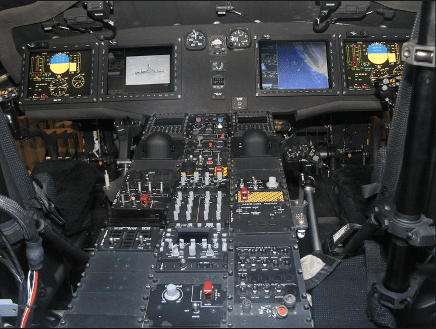Table of Contents
OMIA includes the Mission Display, Flight Display, the Center Console’s Control Display Unit (CDU), as well as the CMP, RCU and FLIR HCU units. OMIA also supports integration with physical hand control units via USB, and flight simulator software to provide an optional ‘out the window’ view.
The core OMIA supports three training configurations: Sierra Pilot, Romeo Pilot, and Romeo Sensor Operator. The expanded Acoustic Training System (ATS) functionality supports in-depth acoustic systems training. In this configuration OMIA-ATS connects to the same helicopter acoustic processor used in the actual helicopter and realistically plays back recorded sonar data. OMIA-ATS supports both dipping sonar, and active and passive sonobuoy processing.
See also the OMIA Datasheet (PDF)
Customer
U.S. Navy
Users
Helicopter crew members and their instructors at the HSC-3 and HSM-41 at Naval Air Station North Island, HSC-2 at Norfolk, HSL-44 at NAS Jacksonville, and HSM-40 at NS Mayport. Many fleet squadrons also use for refresher training.
The Common Cockpit design used by the Navy’s MH-60S and MH-60R helicopters includes all the flight and mission instrumentation. It enables the pilot and co-pilot to share workload through dual flight and mission instrumentation; and to work with the Sensor Operator in the MH-60R. The Navy needed a flexible training system that could function as a part-task trainer for general functionality, simulate multiple seats in a helicopter, as well as be expandable to support in-depth training in particular subsystems, such as active and passive acoustics.
Solution
Since the late 1990s the US Navy’s PMA-205 in conjunction with Stottler Henke has developed/deployed/updated a flexible, low-cost PC-hosted and WEB-hosted Part-Task Trainer (PTT) crew trainer for the Navy’s MH-60S (Sierra) and MH-60R (Romeo) helicopters called the Operator Machine Interface Assistant (OMIA).
The core OMIA is a standalone Java program that operates under any standard Windows 7/8/10/11, Linux, or Macintosh computer. The standalone OMIA is a part-task trainer for the Common Cockpit, including the Mission Display, Flight Display, the Control Display Unit (CDU), as well as the CMP, RCU and FLIR HCU units. OMIA also supports integration with flight simulator software to provide an optional ‘out the window’ view.
The core OMIA supports three training configurations: Sierra Pilot, Romeo Pilot, and Romeo Sensor Operator. There are two in-depth training areas currently supported by OMIA: FLIR and Acoustic. These areas add functionality to the core system described above.The FLIR functionality allows OMIA to function as a FLIR trainer. The FLIR user mainly controls the FLIR operation via a Hand-Control Unit (HCU). OMIA can interface with a portable HCU that is a close facsimile of the actual helicopter’s HCU via USB, or with a software version of the HCU.
The optional Acoustics Training System (ATS) module expands OMIA to OMIA-ATS and provides in-depth acoustic systems training. OMIA-ATS provides “depth” by adding all the functionality for the acoustic Dipper and Buoy sensors. The OMIA-ATS includes:
-
-
- Provides top-level emulation of all operator displays and controls (in an SO configuration or a Pilot/Copilot configuration)
- Provides all the MH-60R Dipper and Buoy acoustic functionality
- Contains the actual operational acoustic signal processing SW used in the helicopter
- Generates Dipper & Buoy returns (active and passive) from simulated targets
- Provides Reeling Machine Control Unit (RMCU) emulation as realistic as what the MH-60R Tactical Operational Flight Trainer (TOFT) provides
- Supports insertion of Sonar Emergency faults and proper response to corrective crew actions defined in the 60R NATOPS Manual
- Can play back and reprocess recorded 60R acoustic data
-
OMIA is currently used in the Navy’s fleet training program for MH-60R and MH-60R helicopter crews. In addition, it is used to familiarize maintenance crews with the MH-60S, and MH-60R cockpits. OMIA is available to all crewmembers at land and at sea.
OMIA Navy Success Story
(Local copy of OMIA Navy Success Story)
Screenshots: simulated flight display, mission display, RCU panel, and CDU.
Video demonstrations: Windows Media Video (WMV):
| MH-60S and MH-60R – Flying with MS Flight Simulator | 2MB, 1 min |
| Demonstration of MH-60R Sensor Operator Training | 2MB, 3 mins |
| Demonstration of MH-60R Sensor Operator Intelligent Tutoring | 5MB, 2 mins |
Publications
Richards, R., and Presnell, B. (2022). OMIA: MH-60R Helicopter Desktop Crew Trainer & Software Change Experimentation Tool. Proceedings of IEEE Aerospace Conference 2022. Big Sky, MT, March 5-12, 2022.
Ludwig, J., Richards, R. (2010) MH60S/R Helicopter Multi-Platform & Web-Based Crew Trainer with FLIR. Proceedings IEEE Aerospace Conference. Big Sky, MT. Powerpoint
JACKSONVILLE NAVY PILOTS TO GET CUTTING EDGE SOFTWARE. The Florida Times-Union (01/26/2010).
Richards, R. J. Ludwig (2008) “Training Benefits of a Java Based Part Task Trainer,” 2008 IEEE Aerospace Conference Proceedings. Big Sky, MT. Powerpoint

MH-60R Common Cockpit